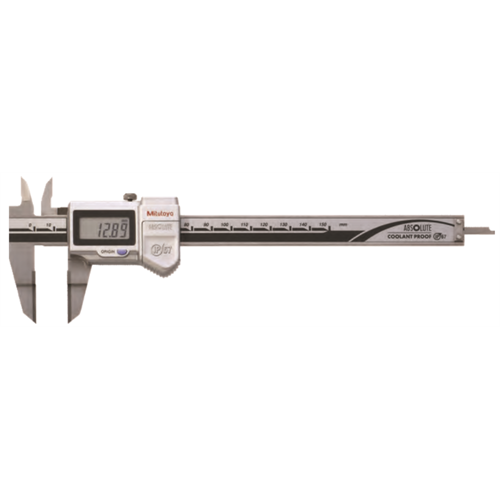Digital vernier calipers

The vernier caliper is the most used tool for measuring parts in the workshop. With the gauge you can do:
Measurement of external dimensions
Measurements of internal dimensions
Depth measurements
Some vernier calipers are equipped with a locking screw these can be used as adjustable templates and used for go-no-go control functions.
The measurement with the caliper is a direct measurement procedure. Vernier calipers have some advantages over other measurement methods, first of all the high ease of use, the immediacy in reading the measurement and above all the ability to work even in work environments with solid or liquid contaminants (emulsions, , dust, water) and with protection on some models up to IP67.
Product Catalog

Mitutoyo digital calipers
- Digital vernier calipers for measuring external and internal diameters
- Square or round depth rod
- Digimatic data output for connection to data acquisition systems and SPCs
- IP67 versions
- With or without fine adjustment wheel
- Special versions with longer jaws or with particular shapes

Hexagon - Tesa digital vernier calipers
- Digital vernier calipers for measuring external and internal diameters
- Square or round depth rod
- Serial data output for connection to data acquisition systems and SPCs
- IP67 versions
- With or without fine adjustment wheel
- Special versions with longer jaws or with particular shapes
Technical insights
Il Vernier caliper it is a type of gauge consisting of a graduated system made of two parts that slide axially between them, and are equipped with appendages (beaks, rods) which serve as a stop for the dimensions to be measured.
Normally it is defined fixed part o the body the part that bears the main gradation, while the other is called the moving part, or simply slider.
The slide has a locking system to avoid accidentally losing the measurement while handling the instrument. Normally, either a friction button or a locking screw are used. The maximum opening of the gauge defines the measuring range.
Classification by type of relief
Depending on the type of appendages, the caliber can be classified:
- external, with beaks designed to hit two walls placed externally with respect to an object
- internal, equipped with beaks or knife appendages designed to hit two walls placed internally with respect to an object
- depth, equipped with a rod designed to hit the bottom of a cavity, while a reference surface rests on the edge of the latter
- universal, equipped with a combination of appendages such as to be able to carry out more types of measurements
The jaws are often made tapered for measuring grooves or hollows.
Particularly critical is the realization of gauges for depth readings: the difficulty in making stable reference surfaces, alignment problems and bending in the rod, limit the measurement accuracy for the cheaper models. Only models designed specifically for this use guarantee adequate measuring accuracy.
Digital caliper
In this type of caliber, a digital electronic indicator is mounted on the slider which detects its movement, while a millimeter scale is normally engraved on the body, but it is used only for the rough verification of the electronic instrument.
Displays are normally made with 0,01mm resolution.
The evolution of electronics has allowed the creation of miniaturized indicators with very low consumption, so much so that they can be easily powered by a common button battery or with solar energy.
Indicators can have several functions:
- display of both metric and English readings;
- zeroing of the reading at an arbitrary point;
- arbitrary setting of a quota;
- serial connection with a PC, in order to automate the measurements (using special software).
Structure
Gauges are traditionally made of stainless steel or high strength materials to prevent corrosion. Often, especially the jaws and the sliding parts, undergo hardening treatments, in order to reduce wear (with consequent measurement errors).
precision.
Some models of calipers have a fine movement wheel for moving the slider, which facilitates fine adjustment of the measurement.
The gauges are built in such a way that the instrument gives maximum precision at the standard temperature of 20 ° C. Measurements made at significantly higher temperatures, and with high resolution instruments, must take into account the expansion of the material with which the gauge itself is built.
Verification and calibration
Verification of a vernier caliper usually consists in checking the smoothness and the absence of mechanical play between the body and the vernier. During the check, the maintenance of the measurement is also checked when the brake screws are tightened. For vernier calipers with digital reading, it is also verified that there are no burnt segments that could give an incorrect reading.
The calibration of a vernier caliper consists of the direct measurement of length samples, such as parallel blocks (usually grade 0 or grade 1) and calibrated rings. In the European industrial environment, the reference standard for the calibration of gauges is EN ISO 13385-1.
The calibration of the vernier calipers, unless otherwise requested, must always refer to a temperature of 20 ° C (68 ° F), the international reference temperature for dimensional measurements.